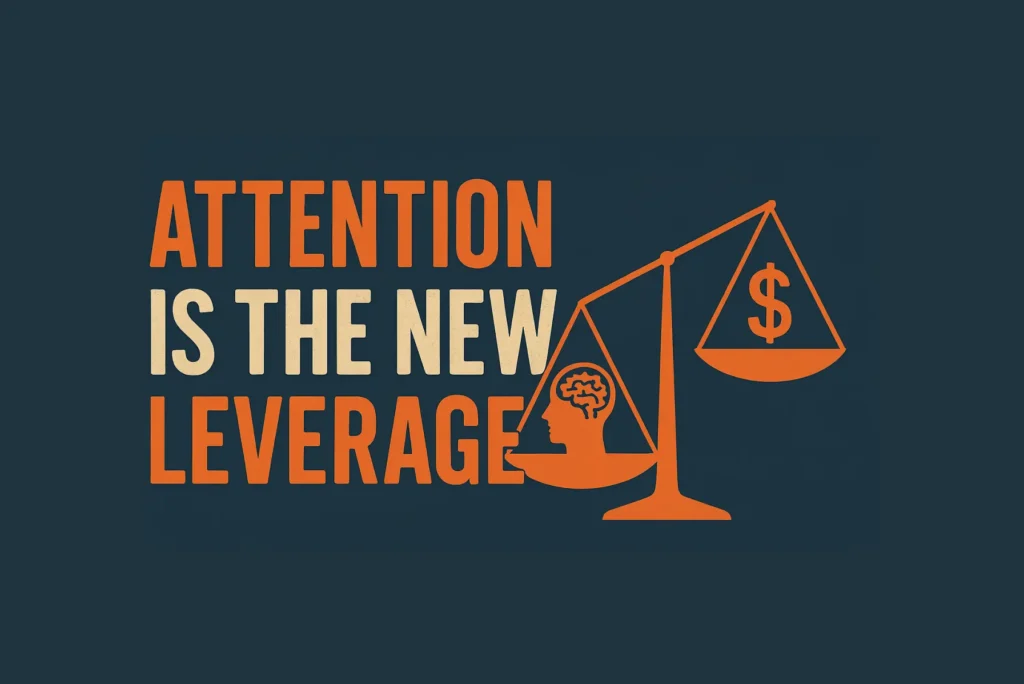
SHANE PIERSON
Purveyor of Honest Capital
I used to think if I just managed my time better, I’d become the kind of SBA lender people talked about. You know the type… calls returned lightning fast, CRM tasks knocked out, pipeline clean, tidy, color-coded. I figured that if I could just cram more deals, more calls, more outbound hustle into my day, I’d hit the next level. And I did all that.
But something was still missing.
The more efficient I became, the more disconnected I felt from the actual borrowers. The more I “handled” deals, the less I actually held space for the human on the other side. I could get through ten conversations in a day and barely remember one of them by dinner.
That’s when I realized the problem: I wasn’t managing my business. I was managing my calendar. And there’s a big difference.
We get sold this myth in banking, and especially in sales, that time is everything. Control your time, and you’ll control your outcomes. But time isn’t the scarce resource anymore. Attention is. And attention is where trust lives. It’s where the magic happens.
In SBA, the borrowers aren’t just applying for loans, they are betting the next chapter of their life on something they probably don’t fully understand. A first-time business buyer with a partner and a seller and a broker and 17 open questions in their head… they don’t care if you logged their call in the CRM or that terrible spreadsheet from 20 years ago pretending to be one. They care if you actually heard them.
They care if you pause long enough to ask, “Hey! What’s keeping you up at night about this deal?” Not because it checks a box. But because you’re really there. You are present. With them. In the mess and uncertainty of a business acquisition.
I had a guy call me recently. He was nervous as can be. His seller was panicking, he didn’t know what to do about his lease transfer, and his CPA was ghosting him. I could’ve said, “Yep, we’ve seen that before,” and moved on to underwriting checklist items. But instead I said, “Let’s slow down. Walk me through it. Forget the loan for a second. What is the seller actually nervous about?” We spent 25 minutes talking. Not about docs… but about people. And that deal closed clean because we calmed it all down at the root.
That wasn’t time management. That was attention management. Time gets deals to committee. Attention gets deals to close.
Where Good Lenders Lose: The Cost of Fractured Focus
You ever seen a deal fall apart after it was conditionally approved? Of course you have. We all have.
It’s that gut-punch scenario where you’ve done the front-end work, issued the LOI, the borrower is excited, the broker’s blowing up your inbox, and then… silence. The file sits. Or worse, it gets hot with problems. Something weird with injection addbacks, a seller who goes dark, a buyer who panics, or documents that get shuffled out of order and no one’s steering the ship.
At first, I thought this was just “part of the business.” But the longer I’ve been in SBA lending, the more I see a clear pattern: Deals don’t fall apart because they’re hard. They fall apart because the lender stopped paying attention.
And I’m not talking about negligence or lack of hustle. I’m talking about fractured mental bandwidth.
The lender gets pulled into another fire drill. A committee review. A pushy borrower blowing up their cell over a separate deal. Or a calendar packed with Teams meetings that make it look like you’re working the deal… but you’re not actually thinking about the deal. You’re moving paper, not managing actual pressure
And that’s when cracks begin to form. They are subtle and invisible at first. A missed email from a seller’s attorney. A buyer asking for a quick call that gets “pushed to Friday.” A funding checklist that turns into a 17-tab spreadsheet abyss because no one slowed down enough to organize the humans driving the transaction.
Let me give you a real one.
I remember this deal a few years ago, a company with three buyers, one seller staying on, and a corporate landlord in the mix. Everything was technically in motion, but I could feel the wheels wobbling. The referral source was seasoned, but even they were frustrated.
The BDO on the deal was smart. He was a sharp, high producer. But he was drowning in fifteen other files and sending quick updates like, “We’re good, just waiting on [XYZ].” No calls. No real engagement. I jumped in and started calling each stakeholder directly. No agenda. Just, “What’s got you stuck?” And what came out were all these little friction points that, if left untended, would’ve blown up the deal:
- Seller worried the training period was too short.
- Buyer unsure if their partner was fully committed.
- Landlord holding up the lease transfer over minor language.
None of that showed up in the loan file. But it was all there… underneath the surface. They were just waiting to derail it.
That’s not a paperwork issue. That’s an attention deficiency.
Here’s what I’ve learned with all of this. You can’t automate trust. You can’t systematize presence. If you’re too scattered to feel where the deal is weak, you’re already behind.
In SBA lending, this is where good lenders plateau. They’ve got the skill. They’ve got the systems. But they’re operating in too many mental tabs. They confuse they daily motions for momentum or progress. And they leave deals vulnerable because they’re not fully with the borrower, the broker, or the process.
Time management says: “Send the email.” Attention management says: “Make the call that clears the fog.”
Attention is the New Leverage: This is how Great Lenders scale trust
Let’s talk about what it actually looks like when attention management isn’t just a concept. It is a hard learned discipline.
Because this isn’t about going slow or turning every file into a therapy session. And it’s definitely not about being touchy feely while deadlines fly by.
It’s about moving with intention. Knowing what deserves your focus and what can wait. It’s the difference between being busy and being effective. Between reacting and orchestrating.
Here’s what I’ve seen work. Both in my own process and with some of the best BDOs and banking teams I’ve seen out there:
1. They create sacred focus zones.
High-performing SBA lenders don’t take calls all day. They time block, but not just for the admin crap. They time block for deep work on deals that matter. They’ll go dark for 90 minutes, knock out credit memos, make high-emotion calls, clear 5-day bottlenecks… and then re-enter the noise.
If you’re always responding to the loudest voice in your inbox, you’re not managing a pipeline. You’re just triaging chaos.
I have a standing rule: when a file hits critical stage: whether it’s funding, seller tension, or closing docs, I get off the email train and into actual conversations. And I don’t pick my head up until I know every person involved has what they need to keep things moving.
2. They treat attention like stewardship.
This is the part most people miss. Your borrower’s story, their fears, their vision, they’re entrusting you with it. And that’s not just a transaction. That’s a stewardship.
In my shop, when a broker sends us a deal, I don’t think, “This is my lead now.” I think, “This is my responsibility now.” That shift alone changes how you show up. It’s not about closing the file. It’s about shepherding the outcome.
Attention management says: I don’t need to touch every deal every day. But the ones that are moving? I need to show up like it matters.
3. They scale trust with simple, human systems.
One of the best hacks I’ve ever built is a “personal radar” list. Not a CRM. Just a short, punchy snapshot of what deals need human attention today. Human friction clearing of sorts. Its the calls I need to make, or the expectations I need to reset. The tensions I need to defuse.
The difference between an average lender and a great one is usually one day. One day too slow to respond. One day too passive with a nervous borrower. One day too distracted to realize a funding deadline was quietly slipping.
The ones who win don’t just work faster. They move with eyes open.
Attention is leverage.
In SBA, speed matters. But trust closes deals. And trust is built when people feel seen, heard, and led, especially when the process gets bumpy.
You don’t get there by managing time. You get there by managing your presence.
I’ll say it again: Time gets deals to underwriting. Attention gets them to closing.
If you want to grow in this business, like really grow, not just stack applications on your “deals at other lenders” part of your spreadsheet, you need to stop worshiping your calendar and start treating your focus as your most sacred asset. Because in a world full of lenders, it’s the ones who manage attention with intention that people remember, refer, and return to.
That’s the difference between being a vendor… And being a trusted voice in someone’s most important financial move.
If this resonated, and if you’re building teams, managing SBA deals, or trying to stand out in a commoditized market, I’d love to hear how you’re applying this. Let’s elevate the craft, not just the close.
